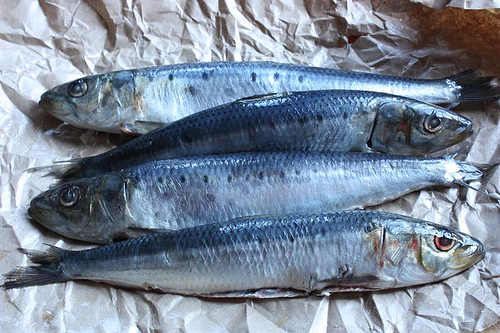
Photo by Andrea Nguyen.
On the Mother Jones website yesterday, contributor and author Julia Whitty posed some important questions about a small, less popular fish that’s begun to come back into vogue in recent years.
The post, called “It’s Okay to Eat Sardines…Right?,” began like this:
Sardines are considered a “sustainable” seafood, one of the few fish you can eat guilt-free, right? Well, not exactly. Forage fish like sardines and anchovies are the key players in huge but delicate food webs known as wasp-waist ecosystems. These are so complex and dynamic that it’s questionable whether we have the know-how to manage them well yet.
Whitty went on to illustrate that we don’t, in fact, seem to know how to manage the world sardine fisheries very well. And she presented a telling and useful chart that tracked the global capture of sardines over the last 50 years. It shows a mountain of consumption that rises steeply in 1975 and goes crashing back down again 20 years later. She also points out that although the Marine Stewardship Council approves of sardine eating, Whitty herself has written in the past about what she sees as lapses in judgement on its part, when it comes to the fishing practices surrounding other types of fish.
I was with Whitty through a great deal of her argument, and I can always get with a considered note of caution about what we eat and how much. So I waited patiently for her to get to the discussion of what happens to the rest of the sardines. But it didn’t come.
You see, as many ocean conservationists and sustainable seafood experts point out, the problem isn’t that people are frying or grilling up too many sardines. The problem is the fish we’re not eating, but feeding to other, farmed fish (like tuna and salmon) and industrially farmed animals (fish oil makes pigs, chickens, and cows grow faster).
The author of a recent New York Times article about forage fish (another name for the small fish generally thought of as feed for other fish), called “Too Many Small Fish Are Caught, Report Says,” put it this way:
The consumer market for forage fish is relatively small; most of the fish are ground and processed for use as animal feed and nutritional supplements and, increasingly, as feed for the aquaculture industry, which now produces about half of all the fish and shellfish that people eat.
A task force from Oregon State University, which has been studying the forage fish crisis for a while now, agrees. Like Whitty, they point to the fact that such fish are critical prey for larger species and a key link in the ocean ecosystem. Last month, the task force released a report, saying:
The harvest of these forage fish has increased with demand, as they are used not only for food … but primarily for fish meal and fish oil to feed farmed fish, pigs and chickens.
And:
The report estimates that forage fish worldwide generate $5.6 billion as direct catch, but contribute more than double that — $11.3 billion — by serving as food for other commercially important fish.
In other words, the role that sardines — and other forage fish like menhaden and anchovies — play in the larger food system is invisible to most of us.
Geoff Shester, the California program director at Oceana, talked to Grist contributor Clare Leschin-Hoar for the article, “Small fish, big ocean: Saving Pacific forage fish.” We followed up with him to ask his take on sardine-eating. In the case of Pacific sardines, he said that “the lion’s share go to bluefin tuna farms (ranches) in Australia, then to commercial longline bait in international tuna fisheries.”
Overall, he says, “consumers are demanding the wrong things. Instead of demanding farmed salmon, which uses at least three pounds of forage fish to get one pound of salmon, people should be demanding the forage fish themselves.”
If all those consumers substituted sardines for a typical meal of farmed salmon or tuna, he adds, they would spend less, while fishermen would command a higher price than they might if they sold the sardines as a mere feed source. We could feed three times more people with the same amount of fishing, and leave many more sardines in the water, where they can remain as part of the ecosystem — and where they are worth way more.
So, not eating sardines might make environmental sense if you’re choosing a plant-based meal instead. Otherwise, the fact that they’re so low on the food chain still makes them a sustainable choice, by comparison to a great deal of the other animal protein available to us.
As Shester puts it: “The best thing we can do right now is make more efficient use of the forage fish we do take out of the ocean.”



